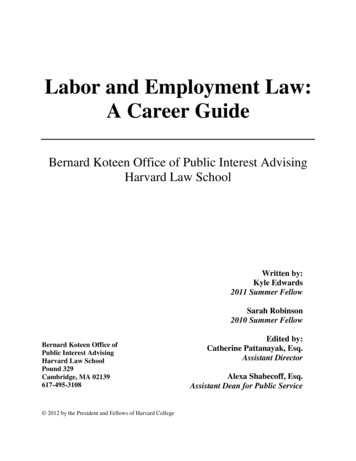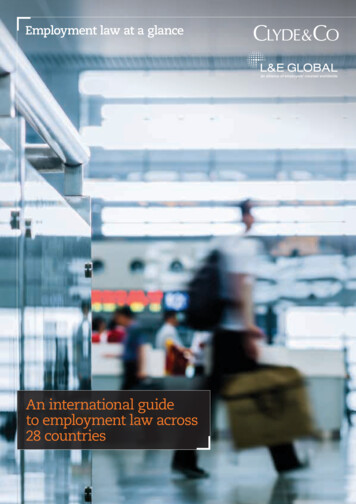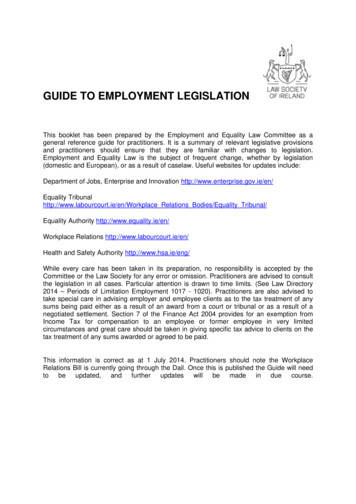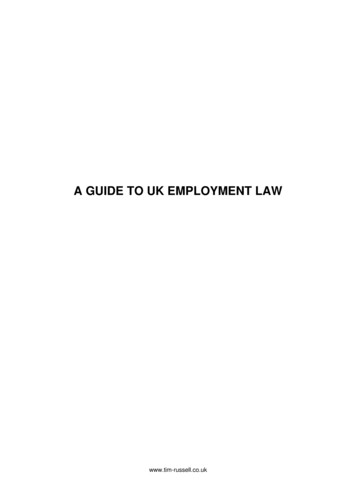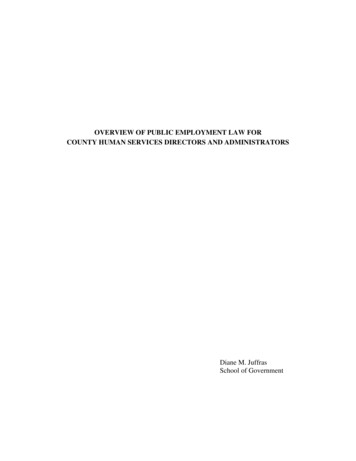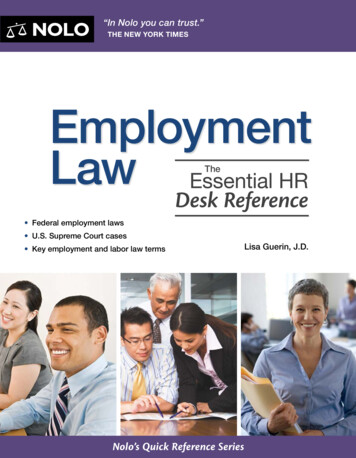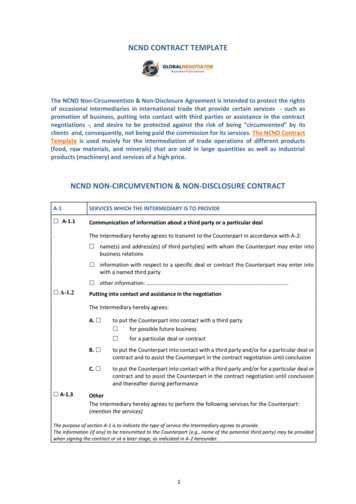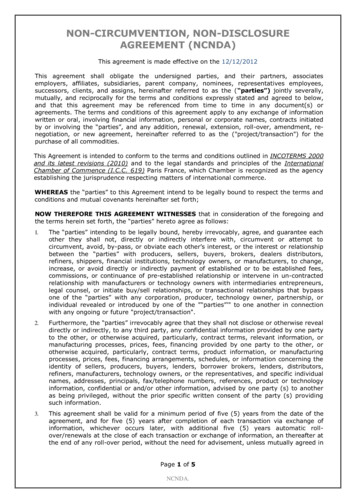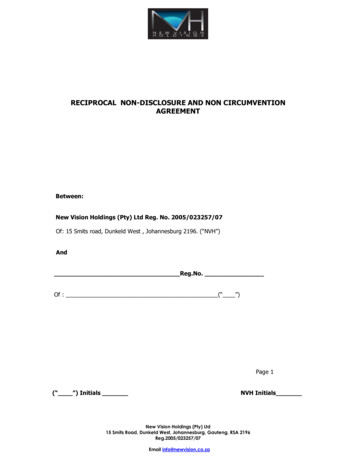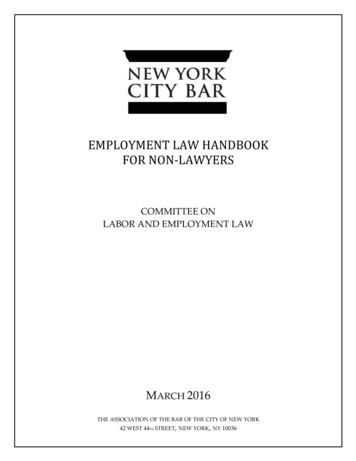
Transcription
EMPLOYMENT LAW HANDBOOKFOR NON-LAWYERSCOMMITTEE ONLABOR AND EMPLOYMENT LAWMARCH 2016THE ASSOCIATION OF THE BAR OF THE CITY OF NEW YORK42 WEST 44TH STREET, NEW YORK, NY 10036
1
This handbook is designed to assist employees who have legal questions abouttheir rights in the workplace.Oftentimes, employees are able to resolve work problems at work and have noneed for the intervention of the courts or an administrative agency. However, sometimesemployees are simply unable to resolve their work place problems at work and requiresome sort of intervention. This pamphlet is designed for those employees who feel theyhave a workplace problem and believe they require outside assistance.Unfortunately for non-lawyers – and occasionally for lawyers as well – the field oflabor and employment law can be extremely complex. The law of the workplace isgoverned by a mixture of Federal, State, and City statutes, some of which overlap andsome of which are mutually exclusive. This pamphlet will provide an overview of thelaws that govern the workplace. It is divided into eight sections:1) The legal relationship between employer and employee2) Wages and pay3) Discrimination4) Whistleblowing5) Unions and collective action6) Heath and safety7) Employment benefits8) Unemployment benefitsIf after reading this pamphlet, you have questions about how these laws apply toyou or about your rights at work, contact the New York City Bar Association’s LegalReferral Service at (212) 626-7373 or http://www.nycbar.org/get-legal-help to speak withan attorney.2
SECTION 1: THE LEGAL RELATIONSHIP BETWEEN EMPLOYER AND EMPLOYEEEmployment at WillApproximately three quarters of New York City’s workers are “at will” employees,1which means their employers can fire them at any time without warning or justification.“At will” employment is based on the notion that individuals should have the right tocontract freely with one another, so an employee can quit at any time without givingnotice, and, in turn, their employer can fire them at any time without notice.As a result of “at will” employment, most New York City employers can legallydemote or fire employees, or cut employees’ pay or benefits, at any time without givingany notice, reason, or justification. Employers are not required to consider the seniorityor work performance of “at will” employees when making decisions about employment.Employers are also not required to issue verbal or written warnings to employees beforefiring them, even if they have done so for other workers and even if their employmenthandbook says they will do so.The only New York City employees who are not employees “at will” areemployees who are union members and those who have individual employmentcontracts. For workers with union contracts or individual contracts, the terms of theircontracts govern when and how their employers can fire them or change the terms oftheir employment.Even “at will” employees have some legal protections, however. The followingsections of this handbook will outline the legal rights that all employees, including “atwill” employees, have in the workplace.1RUTH MILKMAN AND STEPHANIE LUCE, JOSEPH S. MURPHY INSTITUTE FOR WORKER EDUCATION AND LABORSTUDIES, THE STATE OF THE UNIONS 2015 6 (Sept. 2015), available athttps://www.gc.cuny.edu/CUNY 09 Union Density2015 RGB.pdf.3
SECTION 2: WAGE AND PAYEmployee wages and other pay-related regulations are primarily governed by twolaws: the Federal Fair Labor Standards Act (FLSA), which sets certain minimumnational standards, and the New York Labor Law (NYLL), which applies to allemployees working in the State of New York.Fair Labor Standards ActThe FLSA provides that most employees must be paid at least the Federalminimum wage2 for all hours actually worked up to 40 in any given week, and one andone-half their regular rate of pay for each hour actually worked above 40 hours in anygiven week.Certain types of workers are not included in the FLSA’s definition of “employee”and, therefore, are not covered by the minimum wage and overtime rules describedabove. For example, student interns who are engaged in a legitimate internshipprogram related to a course of study and in which the intern is the primary beneficiary ofthe internship are not required to be paid minimum wage or overtime wages. Likewise,non-profit and governmental organizations may employ unpaid volunteers, whereas forprofit entities are generally prohibited from employing unpaid volunteers if their workwould replace work normally done by employees. Independent contractors are anothercategory of workers who, if properly classified, are not subject to the rules of the FLSA.Independent contractors are discussed further, below.Certain types of workers, while considered “employees,” are nonetheless notcovered by the FLSA minimum wage and overtime provisions. These employees arereferred to as “exempt”: Executive Employees: workers who are paid on a salary basis (paid apredetermined amount each pay period regardless of days or hours worked) atleast 455 per week and have, as their primary duty, management dutiesincluding directing two or more full-time employees, are generally exempt. Administrative Employees: workers who are paid on a salary or fee basis at least 455 per week and have, as their primary duty, office or nonmanual work directlyrelated to the management or general business operations of the employer, andwho exercise discretion and independent judgment regarding significantmanagement matters, are generally exempt.2The Federal minimum wage changes frequently; check here for the current rate:www.dol.gov/general/topic/wages/minimumwage.4
Professional Employees: workers who are paid on a salary or fee basis at least 455 per week and have, as their primary duty, work that requires advancedknowledge in a field customarily requiring a prolonged course of specializededucational or intellectual instruction (for example, an attorney, a doctor, anarchitect, or an engineer), and whose work requires consistent exercise ofdiscretion and judgment or invention, imagination, originality or talent in arecognized field of artistic or creative endeavor, are generally exempt. Outside Salesperson: workers who, as a primary duty, regularly engaged inmaking sales or obtaining orders or contracts away from the employer’s place ofbusiness or any fixed location, are generally exempt. Computer Employees: workers who perform certain computer systems analysisand programming work are exempt. Generally, only those who performindependent programming work, such as writing original programs, fall into thisexempt category. In order to be exempt, these employees must also be paidmore than 27.62 per hour or 455 per week on a salary basis. Highly Compensated Employees: workers with a total annual compensation of atleast 100,000 and customarily perform one or more of the exempt duties of anexecutive, administrative, or professional employee, are generally exempt. Thisdoes not apply to outside salespeople or computer employees.Employees who are covered by the FLSA and who are not paid minimum wageor overtime wages as set forth in the law can file a legal action in court to recover thewages he or she should have been paid. Additionally, the employee is entitled torecover an additional equal amount in liquidated damages from the employer if theemployee succeeds in his or her legal action.New York Labor LawThe NYLL also provides for minimum hourly wages to be paid to most employeesperforming work within the State of New York,3 although certain industries are bound byspecific minimum wage rates for that industry, such as fast food workers and tippedworkers.4 Under the NYLL, employees who are required to work more than ten hours inany given day or work a “split shift” are also entitled to be paid for an extra hour of work.3New York State’s minimum wage changes frequently; check the New York Department of Labor for thecurrent rate: orkprot/lshmpg.shtm.4For industry-specific minimum wage information, see the New York Department of Labor’s website s/workprot/MW%20Updates/minimum-wageupdate.shtm.5
Like the FLSA, certain workers are “exempt” from the provisions of the NYLL,including part-time babysitters, outside salespeople, and live-in companions, althoughother regulations may apply to such workers.The NYLL includes many of the same exemptions as the FLSA, including theExecutive Employee, Administrative Employee, and Professional Employeeexemptions. However, for these exemptions to apply in New York, the employee mustbe paid a minimum of 675 per week (rather than 455 under the FLSA). As a practicalmatter, this means that an employee in one of these categories of employment who ispaid a salary of more than 455 but less than 675 may still have legal claims under theNYLL if she or he is not paid the required minimum wage or overtime rates.Employees who are covered by the FLSA and who are not paid minimum wageor overtime wages as set forth in the law can file a legal action in court to recover thewages he or she should have been paid. Additionally, the employee is entitled torecover an additional equal amount in liquidated damages from the employer if theemployee succeeds in his or her legal action.In New York, under the Wage Theft Protection Act, employers are also requiredto provide every new hire with a written notice of wage rates, which must include: The rate or rates of pay, including the overtime rate of pay if applicable; How the employee will be paid (by the hour, shift, day, week, commission,etc.); The regular pay day; The official name of the employer and any other names used by thebusiness, including “doing business as” names; The address and phone number of the employer’s main office or principallocation; and Any allowances that will be taken as part of the minimum wage (tips,meals, and lodging deductions), if applicable.In addition, employers are required to provide a wage statement or pay stub on eachpay day that lists all of this information plus the employee’s name, the employer’s name,address, and phone number, as well as stating the dates of work covered by thepayment.6
Failure to comply with the Wage Theft Protection Act can lead to the employerbeing investigated and fined by the Department of Labor, or subject the employer todamages in a civil law suit by an employee.Independent ContractorsIndividuals who perform work for another individual or entity as an independentcontractor is not an “employee” under either the FLSA or the NYLL. Independentcontractors are not entitled to overtime or minimum wage under the law, and employersare not required to withhold or pay payroll taxes for independent contractors.In New York, the Department of Labor defines independent contractors asworkers who are free from “supervision, direction, and control in the performance oftheir duties.” They are in business for themselves and generally offer their services tothe general public, not just one entity or individual. Some signs that a person is anindependent contractor include (but are not limited to): having an established businessentity and place of business, advertising that business, carrying appropriate insurancein the individual or business name, paying his or her own business expenses, setting hisor her own business and work hours, refusing work offers when he or she wishes to,and hiring help when appropriate.Similarly, under Federal law, including the FLSA, courts apply what is referred toas the “economic realities” test to determine whether someone has been misclassifiedas an independent contractor. Although there are many relevant factors, similar to thoseet forth above, this rule essentially looks to whether the worker had economicindependence from the business he or she provided services to or if the worker wasactually economically dependent on the employer.These definitions and tests are important, since employers sometimes arbitrarilyclassify and pay workers as independent contractors even though they are performingwork in a way that actually fits the definition of “employee.” This kind of situation isreferred to as “misclassification” and if it results in an employee not being provided withthe benefits of an employee, including but not limited to minimum wage and overtimepay, it can lead to legal action and investigation of the employer by State and Federalagencies. Accordingly, both State and Federal law make it clear that the ultimate inquiryis about the actual duties of the worker and relationship between the worker andemployer, and not about the label given to the relationship.7
SECTION 3: DISCRIMINATIONAll employees have the right to a workplace free from unlawful discrimination.However, not all types of unfair or differential treatment are legally-prohibiteddiscrimination. For example, an employee who is fired because of nepotism, favoritism,or a misunderstanding is not protected by the anti-discrimination laws. Federal, state,and city anti-discrimination laws each have a list of reasons that employers areforbidden from relying on when making employment decisions. If an employer relies onone of these prohibited reasons, they have engaged in unlawful discrimination.Federal lawAge (over 40 years old)State Human Rights LawAgeCity Human Rights LawAgeRaceRaceRaceColorColorColorNational originNational originNational nderGender identity/expressionSexual orientationSexual orientationPregnancyPregnancyFamilial statusCaregiver statusDisabilityDisabilityDisabilityGenetic characteristicsGenetic characteristicsPregnancyMarital statusMarital/Partnership statusMilitary statusAlienage/Citizenship statusArrest/Conviction recordArrest/Conviction recordStatus as a victim ofdomestic violenceStatus as a victim ofdomestic violence, sexualviole
labor and employment law can be extremely complex. The law of the workplace is governed by a mixture of Federal, State, and City statutes, some of which overlap and some of which are mutually exclusive. This pamphlet will provide an overview of the laws that govern the


